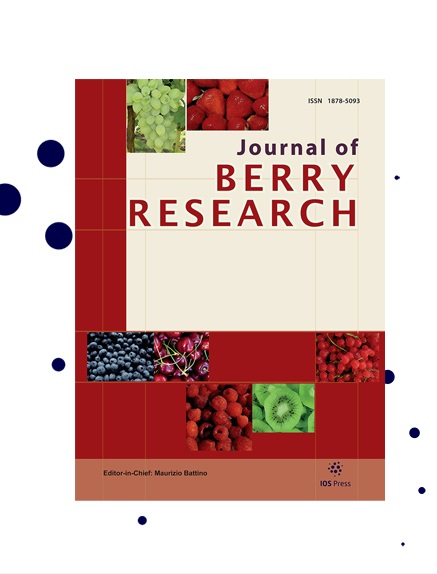Metabolomic screening and urolithins metabotypes identification in the urinary metabolome of Costa Rican volunteers after blackberry ( Rubus adenotrichos)-based drink consumption
IF 1.4
4区 农林科学
Q3 PLANT SCIENCES
引用次数: 0
Abstract
BACKGROUND:Besides providing nutritional value, functional foods have potential beneficial effects on health. Consumers worldwide seek food products with added value based on physical and mental well-being. OBJECTIVE:This study aimed to analyze the urinary metabolome of volunteers who consumed a drink based on Costa Rican blackberries (Rubus adenotrichos) to identify the presence of urolithins and other possible bioactive compounds related to beneficial effects on health. METHODS:Fifteen healthy non-smoking male volunteers aged between 19 and 43 years old who consumed 250 ml of blackberry-based drink for breakfast for eight consecutive days were selected. Urine samples were obtained before and after drink consumption, which were submitted to analysis by Ultra-Performance Liquid Chromatography coupled to a Mass Detector (UPLC/ESI-Q-TOF-MS). Subsequently, a metabolomic analysis of the results was performed to identify the presence or absence of urolithins and other bioactive metabolites related to blackberry juice consumption. RESULTS:It was possible to detect high intensity presence of urolithin A (n = 6) and high intensity presence of both urolithin A and B (n = 5) in urine samples in several volunteers. However, finding them was impossible in others, or they were at very low intensities (n = 4). Likewise, it was possible to identify Menth-1-en-4,8 diol glucuronide and 1-O-E-Cinnamoyl-(6-arabinosylglucose) as other compounds related to the consumption of blackberries. CONCLUSIONS:The consumption of Costa Rican blackberries allowed us to demonstrate the presence of three metabotypes within the study population: 40% of strong urolithin A (UAP) producers, 33.3% of both urolithin (A and B) producers (UBP), and 26.7% of weak urolithin A producers (0P). Finally, it is recommended to carry out more research in this regard, considering a greater number of volunteers and including people of both sexes.哥斯达黎加志愿者饮用黑莓(Rubus adenotrichos)饮料后尿液代谢组的代谢组筛选和尿石素代谢型鉴定
背景:除了提供营养价值,功能食品还对健康有潜在的益处。全世界的消费者都在寻求具有身心健康附加值的食品。目的:本研究旨在分析饮用哥斯达黎加黑莓(Rubus adenotrichos)饮料的志愿者的尿液代谢组,以确定其中是否含有尿石素和其他可能对健康有益的生物活性化合物。方法:选取 15 名健康的非吸烟男性志愿者,年龄在 19 至 43 岁之间,连续八天在早餐时饮用 250 毫升黑莓饮料。在饮用饮料前后采集尿液样本,并通过超高效液相色谱-质谱联用仪(UPLC/ESI-Q-TOF-MS)进行分析。随后,对结果进行了代谢组学分析,以确定是否存在与饮用黑莓汁有关的尿石素和其他生物活性代谢物。结果:在几名志愿者的尿液样本中,可以检测到高浓度的尿石素 A(6 人)和高浓度的尿石素 A 和 B(5 人)。然而,在其他志愿者的尿样中却无法找到这些物质,或者它们的强度非常低(4 人)。同样,还可以确定薄荷-1-烯-4,8 二醇葡萄糖醛酸内酯和 1-O-E-肉桂酰-(6-阿拉伯糖基葡萄糖)是与食用黑莓有关的其他化合物。结论:食用哥斯达黎加黑莓使我们能够证明研究人群中存在三种代谢类型:40%的强尿石素 A(UAP)生成者、33.3%的尿石素(A 和 B)生成者(UBP)和 26.7%的弱尿石素 A 生成者(0P)。最后,建议在这方面开展更多的研究,考虑更多的志愿者,并将男女志愿者都包括在内。
本文章由计算机程序翻译,如有差异,请以英文原文为准。
求助全文
约1分钟内获得全文
求助全文
来源期刊

Journal of Berry Research
Biochemistry, Genetics and Molecular Biology-Biochemistry
CiteScore
3.50
自引率
11.80%
发文量
21
期刊介绍:
The main objective of the Journal of Berry Research is to improve the knowledge about quality and production of berries to benefit health of the consumers and maintain profitable production using sustainable systems. The objective will be achieved by focusing on four main areas of research and development:
From genetics to variety evaluation
Nursery production systems and plant quality control
Plant physiology, biochemistry and molecular biology, as well as cultural management
Health for the consumer: components and factors affecting berries'' nutritional value
Specifically, the journal will cover berries (strawberry, raspberry, blackberry, blueberry, cranberry currants, etc.), as well as grapes and small soft fruit in general (e.g., kiwi fruit). It will publish research results covering all areas of plant breeding, including plant genetics, genomics, functional genomics, proteomics and metabolomics, plant physiology, plant pathology and plant development, as well as results dealing with the chemistry and biochemistry of bioactive compounds contained in such fruits and their possible role in human health. Contributions detailing possible pharmacological, medical or therapeutic use or dietary significance will be welcomed in addition to studies regarding biosafety issues of genetically modified plants.
 求助内容:
求助内容: 应助结果提醒方式:
应助结果提醒方式:


